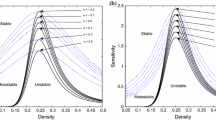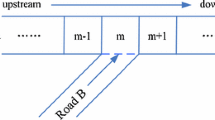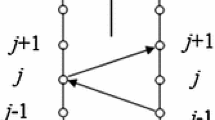Abstract
The self-anticipative density (SAD) term is embedded to traffic modeling for two-lane freeway in this paper. In view of linear stability analysis, SAD effect on two lanes is uncovered from the linear stability condition, which reveals that SAD effect in two-lane system stabilizes traffic flow. Moreover, numerical simulation verifies that SAD effect can increase the traffic stability and depress the traffic jam efficiently in new two-lane lattice model.














Similar content being viewed by others
References
Newell, G.F.: A simplified car-following theory: a lower order model. Transp. Res. B 36, 195–205 (2002)
Bando, M., Hasebe, K., Nakayama, A., Shibata, A., Sugiyama, Y.: Dynamical model of traffic congestion and numerical simulation. Phys. Rev. E 51, 1035–1042 (1995)
Helbing, D., Tilch, B.: Generalized force model of traffic dynamics. Phys. Rev. E 58, 133–138 (1998)
Jiang, R., Wu, Q., Zhu, Z.: Full velocity difference model for a car-following theory. Phys. Rev. E 64, 017101 (2001)
Li, Z.P., Liu, Y.C., Liu, F.Q.: A dynamical model with next-nearest-neighbor interaction in relative velocity. Int. J. Modern Phys. C 18, 819–832 (2007)
Li, Z.P., Zhang, R., Xu, S.Z., Qian, Y.Q., Xu, J.: Stability analysis of dynamic collaboration model with control signals on two lanes. Commun. Nonlinear Sci. Numer. Simul. 19, 4148–4160 (2014)
Li, Z.P., Li, W.Z., Xu, S.Z., Qian, Y.Q.: Analyses of vehicle’s self-stabilizing effect in an extended optimal velocity model by utilizing historical velocity in an environment of intelligent transportation system. Nonlinear Dyn. 80, 529–540 (2015)
Li, Z.P., Liu, L.M., Xu, S.Z., Qian, Y.Q.: Impact of driving aggressiveness on the traffic stability based on an extended optimal velocity mode. Nonlinear Dyn. 81, 2059–2070 (2015)
Zhu, W.X., Yu, R.L.: A new car-following model considering the related factors of a gyroidal road. Physica A 393, 101–111 (2014)
Zhu, W.X., Zhang, L.D.: A speed feedback control strategy for car-following model. Physica A 413, 343–351 (2014)
Zhu, W.X.: Motion energy dissipation in traffic flow on a curved road. Int. J. Modern Phys. C 24, 1350046 (2013)
Zhu, W.X., Zhang, C.H.: Analysis of energy dissipation in traffic flow with a variable slope. Physica A 392, 3301–3307 (2013)
Zhou, J., Shi, Z.K., Cao, J.L.: Nonlinear analysis of the optimal velocity difference model with reaction-time delay. Physica A 396, 77–87 (2014)
Zhou, J., Shi, Z.K., Cao, J.L.: An extended traffic flow model on a gradient highway with the consideration of the relative velocity. Nonlinear Dyn. 78, 1765–1779 (2014)
Tang, T.Q., Shi, W.F., Shang, H.Y., Wang, Y.P.: A new car-following model with consideration of inter-vehicle communication. Nonlinear Dyn. 76, 2017–2023 (2014)
Tang, T.Q., He, J., Yang, S.C., Shang, H.Y.: A car-following model accounting for the driver’s attribution. Physica A 413, 583–591 (2014)
Tang, T.Q., Shi, W.F., Shang, H.Y., Wang, Y.P.: An extended car-following model with consideration of the reliability of inter-vehicle communication. Measurement 58, 286–293 (2014)
Tang, T.Q., Huang, H.J., Shang, H.Y.: Influences of the driver’s bounded rationality on micro driving behavior, fuel consumption and emissions. Transp. Res. D 41, 423–432 (2015)
Ge, H.X., Yu, J., Lo, S.M.: A control method for congested traffic in the car-following model. Chin. Phys. Lett. 29, 050502 (2012)
Ge, H.X., Lv, F., Zheng, P.J., Cheng, R.J.: The time-dependent Ginzburg–Landau equation for car-following model considering anticipation-driving behavior. Nonlinear Dyn. 76, 1497–1501 (2014)
Ge, H.X., Meng, X.P., Zhu, H.B., Li, Z.P.: Feedback control for car following model based on two-lane traffic flow. Physica A 408, 28–39 (2014)
Ge, H.X., Zheng, P.J., Wang, W., Cheng, R.J.: The car following model considering traffic jerk. Physica A 433, 274–278 (2015)
Nagel, K., Schreckenberg, M.: A cellular automaton model for freeway traffic. J. Phys. I 2, 2221–2229 (1992)
Knospe, W., Santen, L., Schadschneider, A., Schreckenberg, M.: Disorder effects in cellular automaton for two-lane traffic. Physica A 265, 614–633 (1998)
Nishinari, K., Takahashi, D.: Analytical properties of ultradiscrete Burgers equation and rule-184 cellular automaton. J. Phys. A 31, 5439–5450 (1998)
Nishinari, K., Takahashi, D.: Multi-value cellular automaton models and metastable states in a congested phase. J. Phys. A 33, 7709–7720 (2000)
Jiang, R., Jia, B., Wu, Q.S.: Stochastic multi-value cellular automata models for bicycle flow. J. Phys. A 37, 2063–2072 (2004)
Zhang, X.Q., Wang, Y., Hu, Q.H.: Research and simulation on cellular automaton model of mixed traffic flow at intersection. Acta Physica Sin. 63, 10508 (2014)
Ge, H.X., Wu, S.Z., Cheng, R.J., Lo, S.M.: Theoretical analysis of a modified continuum model. Chin. Phys. Lett. 28, 090501 (2011)
Ge, H.X., Lo, S.M.: The KdV-Burgers equation in speed gradient viscous continuum model. Physica A 391, 1652–1656 (2012)
Tang, T.Q., Caccetta, L., Wu, Y.H., Huang, H.J., Yang, X.B.: A macro model for traffic flow on road networks with varying road conditions. J. Adv. Transp. 48, 304–317 (2014)
Tang, T.Q., Huang, H.J., Shang, H.Y.: An extended macro traffic flow model accounting for the driver’s bounded rationality and numerical tests. Physica A 468, 322–333 (2017)
Nagatani, T.: Modified KdV equation for jamming transition in the continuum models of traffic. Physica A 261, 599–607 (1998)
Nagatani, T.: TDGL and MKdV equations for jamming transition in the lattice models of traffic. Physica A 264, 581–592 (1999)
Nagatani, T.: Jamming transition in traffic flow on triangular lattice. Physica A 271, 200–221 (1999)
Nagatani, T.: Jamming transition in a two-dimensional traffic flow model. Phys. Rev. E 59, 4857–4864 (1999)
Nagatani, T.: Jamming transition of high-dimensional traffic dynamics. Physica A 272, 592–611 (1999)
Ge, H.X., Cheng, R.J., Lo, S.M.: Time-dependent Ginzburg-Landau equation for lattice hydrodynamic model describing pedestrian flow. Chin. Phys. B 22, 104–108 (2013)
Ge, H.X., Cheng, R.J., Lo, S.M.: A lattice model for bidirectional pedestrian flow on gradient road. Commun. Theor. Phys. 62, 259–264 (2014)
Redhu, P., Gupta, A.K.: Phase transition in a two-dimensional triangular flow with consideration of optimal current difference effect. Nonlinear Dyn. 78, 957–968 (2014)
Gupta, A.K., Redhu, P.: Analyses of the driver’s anticipation effect in a new lattice hydrodynamic traffic flow model with passing. Nonlinear Dyn. 76, 1001–1011 (2014)
Redhu, P., Gupta, A.K.: Jamming transitions and the effect of interruption probability in a lattice traffic flow model with passing. Physica A 421, 249–260 (2014)
Gupta, A.K., Redhu, P.: Jamming transition of a two-dimensional traffic dynamics with consideration of optimal current difference. Phys. Lett. A 377, 2027–2033 (2013)
Redhu, P., Gupta, A.K.: Effect of forward looking sites on a multi-phase lattice hydrodynamic model. J. Phys. A 445, 150–160 (2016)
Zhang, G., Sun, D.H., Liu, H., Chen, D.: Stability analysis of a new lattice hydrodynamic model by considering lattice’s self-anticipative density effect. Physica A 486, 806–813 (2017)
Ge, H.X., Cheng, R.J.: The backward looking effect in the lattice hydrodynamic model. Physica A 387, 6952–6958 (2008)
Ge, H.X., Cui, Y., Zhu, K.Q., Cheng, R.J.: The control method for the lattice hydrodynamic model. Commun. Nonlinear Sci. Numer. Simul. 22, 903–908 (2015)
Tian, C., Sun, D.H., Zhang, M.: Nonlinear analysis of lattice model with consideration of optimal current difference. Commun. Nonlinear Sci. Numer. Simul. 16, 4524–4529 (2011)
Tian, J.F., Jia, B., Li, X.G.: Flow difference effect in the lattice hydrodynamic model. Chin. Phys. B 19, 040303 (2010)
Wang, T., Gao, Z.Y., Zhao, X.M.: Multiple flux difference effect in the lattice hydrodynamic model. Chin. Phys. B 21, 020512 (2012)
Nagatani, T.: Jamming transitions and the modified Korteweg–de Vries equation in a two-lane traffic flow. Physica A 265, 297–310 (1999)
Tang, T.Q., Huang, H.J., Xue, Y.: An improved two-lane traffic flow lattice model. Acta Physica Sin. 55, 4026–4031 (2006)
Li, Z.P., Zhang, R., Xu, S.Z., Qian, Y.Q.: Study on the effects of driver’s lane-changing aggressiveness on traffic stability from an extended two-lane lattice model. Commun. Nonlinear Sci. Numer. Simul. 24, 52–63 (2015)
Zhang, G., Sun, D.H., Liu, W.N.: Analysis of a new two-lane lattice hydrodynamic model with consideration of the global average flux. Nonlinear Dyn. 81, 1623–1633 (2015)
Zhang, G., Sun, D.H., Liu, W.N., Zhao, M., Cheng, S.L.: Analysis of two-lane lattice hydrodynamic model with consideration of drivers’ characteristics. Physica A 422, 16–24 (2015)
Zhang, G., Sun, D.H., Zhao, M., Liu, W.N., Cheng, S.L.: Analysis of average density difference effect in a new two-lane lattice model. Int. J. Modern Phys. C 26, 1550062 (2015)
Gupta, A.K., Redhu, P.: Analyses of drivers anticipation effect in sensing relative flux in a new lattice model for two-lane traffic system. Physica A 392, 5622–5632 (2013)
Sharma, S.: Lattice hydrodynamic modeling of two-lane traffic flow with timid and aggressive driving behavior. Physica A 421, 401–411 (2015)
Sharma, S.: Effect of driver’s anticipation in a new two-lane lattice model with the consideration of optimal current difference. Nonlinear Dyn. 81, 991–1003 (2015)
Tian, J.F., Yuan, Z.Z., Jia, B., Li, M.H., Jiang, G.J.: The stabilization effect of the density difference in the modified lattice hydrodynamic model of traffic flow. Physica A 391, 4476–4482 (2012)
Wang, T., Gao, Z.Y., Zhang, J.: Stabilization effect of multiple density difference in the lattice hydrodynamic model. Nonlinear Dyn. 73, 2197–2205 (2013)
Wang, T., Gao, Z.Y., Zhang, J., Zhao, X.: A new lattice hydrodynamic model for two-lane traffic with the consideration of density difference effect. Nonlinear Dyn. 75, 27–34 (2014)
Gupta, A.K., Redhu, P.: Analysis of a modified two-lane lattice model by considering the density difference effect. Commun. Nonlinear Sci. Numer. Simul. 19, 1600–1610 (2014)
Acknowledgements
This work was supported by the National Natural Science Foundation of China (Grant No. 61673168).
Author information
Authors and Affiliations
Corresponding authors
Ethics declarations
Conflict of interest
We guarantee that this work has no conflict of interest to other researches.
Rights and permissions
About this article
Cite this article
Peng, G., Yang, S., Xia, D. et al. Impact of lattice’s self-anticipative density on traffic stability of lattice model on two lanes. Nonlinear Dyn 94, 2969–2977 (2018). https://doi.org/10.1007/s11071-018-4537-y
Received:
Accepted:
Published:
Issue Date:
DOI: https://doi.org/10.1007/s11071-018-4537-y




